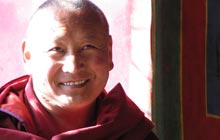
 Foundation of the Gelug Sect
Foundation of the Gelug Sect
Tsong Khapa (1357-1419) founded Ganden monastery in 1409. A graduate of the austere Karmapa order, his doctrine emphasized monastic discipline. This attitude was echoed by his reinforcement of the primacy of sutras – the original teachings of Buddha – over the tantras – later mystical teachings. So popular was his movement that new monasteries were soon opened at Sera, Drepung & Tashilhunpo, and the sect took on the name of Gelug or "Virtuous Ones".
Dalai Lama
During the tenure of the third Gelugpa leader, Sonam Gyatso (1543-1588), a Mongolian force invaded Tibet. When the Mongol leader, the Altan Khan, met Sonam Gyatso he was so awed as to immediately convert to Buddhism. As part of the ensuing priest patron relationship, the Khan conferred the title Dalai Lama or "Oceanic Teacher" upon Sonam Gyatso, who retroactively applied it to his two predecessors, thereby becoming the Third Dalai Lama.
In 1640, when civil unrest again arose in Tibet, the Fifth Dalai Lama, Ngawang Lobsang Gyatso (1617-1682) applied for assistance from his associates, the Mongols. It was after their subsequent pacification of the nation, that the Mongols invested him with complete political control. The Fifth Dalai Lama thereby became the spiritual and temporal leader of Tibet. So capable was he, in both temporal and spiritual realms, that this Dalai Lama is often referred to as the "Great Fifth".
The current Dalai Lama, Tenzin Gyatso, (1935 – ) is the Fourteenth one. Like those before him, he is held to be the reincarnation of the Bodhisattva of Compassion, Avalokiteshvara. The concept of reincarnation is fundamental to the continued lineage of the Dalai Lama. This is maintained by the discovery of a young child born soon after the death of a previous Dalai Lama. It is believed that the life-spirit of the deceased transfers to the newly found child, who takes on the pre-ordained mantle of the Dalai Lama.
Panchen Lama
In the 17th century, the Fifth Dalai Lama declared his tutor, the abbot of the Tashilhunpo monastery, Panchen Lama or the "Great Scholar" Lama. This abbot, by retroactively applying the title to the three abbots preceding him, thereby became the Fourth Panchen Lama. As such, he was believed to be the reincarnation of Amitabha, the Buddha of Infinite Light. Like the lineage of the Dalai Lama, the Panchen Lama's lineage is preserved through a process of reincarnation. The current Panchen Lama is the Eleventh in line.
For centuries, the Dalai Lamas and Panchen Lamas initiated one another as divine leaders, the older one customarily serving as tutor to the younger one. However, with the rise in influence of the Panchen Lama at certain times he came to be seen as a political rival rather than a partner of the Dalai Lama.